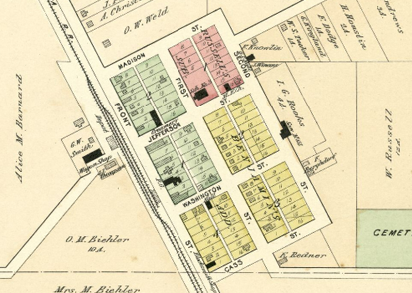
NEW RAILROAD STATION
Big Rapids Independent, 1870
On 12 October 1870 the owners of O.P. Pillsbury & Co., Annie and David M. Benjamin, Vesta and Oliver Pillsbury, and Chole, Daniel, Edward, Alice, William and Emma Bradley, recorded the plat of the Village of Stanwood.

VILLAGE OF STANWOOD
Big Rapids Independent, August 5, 1871
Stanwood is among the numerous little towns which have sprung into existence along the line of the Grand Rapids and Indiana Railroad since its completion northward from Grand Rapids, and is situated in the town of Mecosta, in this county, about eight miles south of Big Rapids. On the first day of October last, Messrs. O. P. Pillsbury & Co. commenced clearing away the brush and timber for a depot site, and in about two weeks they had a good substantial frame station house, of the same dimensions of those in Big Rapids, completed and ready for use. This was the first building erected in that vicinity. Immediately on the heel of this, they commenced the rection of a large frame hotel, which was finished and in running order before winter set in.
Last spring they erected a large shingle mill which was equipped with machinery of the very best quality and furnishes steady employment to thirteen men and boys who turn out twenty-two thousand shingles per day. The mill is situated about sixty rods [0.2 miles] from the depot on the bank of Mack Creek, which is dammed at this point, to provide boomage for the logs to be manufactured into shingles. This stream is of considerable magnitude, and with but a moderate outlay, would furnish a valuable water power.
A few rods from the depot, on the eastern side of the tract, stands the large store building of S. W. Foster and David D. Tarr. It is 26 by 52 feet in size and two stories high, the upper story being occupied by Mr. Tarr for a dwelling. The proprietors are just opening a very fair stock of groceries and provisions, and will no doubt receive a liberal patronage from the inhabitants of that vicinity. Here too is the Post Office, which bears the same name as the station, and is presided over with almost clerical dignity by Mr. Tarr.
The hotel was recently purchased by D. W. Palmer, Esp., who has just taken possession, and is renovating and refurnishing it from cellar to garret. The house is admirably arranged and the rooms are large and commodious, and when Mr. Palmer gets things “settled,” the traveler will find it a better stopping place than many large towns afford.
Messrs. O. P. Pillsbury & Co., have now in process of erection a two story store building, 30 by 60 feet in size, and a blacksmith and carpenter shop 24 by 60 feet. The frame for the latter is already up, and the timbers for the former are nearly ready for raising. They also have, beside the side-track, a shed which will hold 700,000 shingles, and they no whave on hand about 500,000. When thoroughly seasoned they propose to ship them to Boston, Mass. By holding them until they are seasoned, they are able to ship about fifteen thousand more to each car load than they can while green, which in the shipment of a large quantity and to do so great a distance makes an item worth saving.
Among the dwellings in town, that of W. T. Russel is most conspicuous. It is 24 by 34 feet in sixe and two storieshigh. The style and quality of its workmanship and finish are equal to the best houses in Big Rapids. It may not be inappropriate here to remark that it was built by John McNaughton, Esg., of this city, who was the master builder of every structure but two in Stanwood. He has been engaged there with quite a force of men, the greater part of the time since the first of October last.
Stanwood is not a “Shanty Town.” All the buildings are large and built in that substantial style which testifies to the good judgement of their projectors, and give the place an air of permanence. It is in the midst of a belt of valuable timber, which, for pine land, has an excellent soil, with a large territory of rich farming country both east and west of it; and while it is not expected that Stanwood will become a great city, yet it is not too much to say that it will soon be one of the most important intermediate stations on the Grand Rapids & Indiana Railroad.
We should do injustice to Messrs. S. W. Foster and LaFora S. Baker, who are in the employ of O. P. Pillsbury & Co., were we to close this article without thanking them (which we do with one of our profoundest bows) for information given and courtesies extended furing our recent brief visit to Stanwood. (Copied Verbatim)
